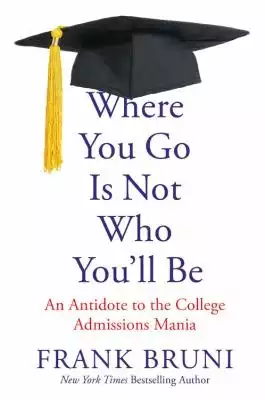
That there are 15 people on the hold list for Frank Bruni’s new book, “Where You Go Is Not Who You’ll Be: An Antidote to the College Admissions Mania” is not surprising to me. If anything, I would have expected the number to be much higher. I’m one of the 15 people waiting, just as I waited awhile for my turn to read William Deresciwicz’s fascinating “Excellent Sheep: The Miseducation of the American Elite and the Way to a Meaningful Life.” As someone who’s lived here for 25 years, the wait-list numbers are the result of a simple fact: outside of the university that shares its name, Princeton exists for college admissions.
When I returned home from a bike ride with my son on a recent Saturday, my wife had news to share: a kid we know who had applied to all of the Ivy League schools hadn’t been accepted at any and was traumatized by this news. This kid had to “settle” for a highly regarded (and highly selective) non-Ivy. I say that not out of indifference — indeed, I feel great sympathy for this kid and his parents — but to point out how deeply distressing this news can be for young people in Princeton. The conversation with my wife was a series of who’s-going-where stories that have been commonplace for several years now. In Princeton we talk about college admissions the way, in another town, they might talk about their high school football team. Here, the conversations are not about Friday Night Lights, but about Saturday Morning SATs.
Colleagues who raised kids in neighboring towns point out that this mania is everywhere, but in Princeton, it is on steroids. It’s why our high school has a program of studies that rivals some colleges. It’s why teachers in our public schools are paid, on average, about $10,000 more than teachers in most other local high-performing districts. It’s why when the library has a college essay program, spaces fill instantly and there is a wating list. It’s also why many of our kids put in the same hours as corporate lawyers and end up stressed out and exhausted.
And it’s why our daily conversations are filled with topics related to our own kids’ college admissions process and why we share stories about other kids. Most of these stories have benign endings — kids either get in to the school they want or they don’t — but some, particularly the stories of rejection, have darker elements attached.
The day after that Saturday admissions conversation, Bruni’s column about sucides among high school students in Palo Alto appeared in the Sunday Review section of The New York Times, sending shock waves through parent communities in Princeton and other towns with high-achieving high schools. It’s clear from the column that Bruni is well-versed on this issue, but for me the most compelling part was this quote from a Palo Alto High School junior: “We are not teenagers. We are lifeless bodies in a system that breeds competition, hatred, and discourages teamwork and genuine learning.”
It seems that every year at application and acceptance/rejection time, multiple columns appear decrying what Bruni’s flap copy calls “this terrifying and occassionally devastating process.” Yet, like a Category 5 hurricane barreling up the coast, we watch this process closely and feel powerless to do anything about it, except to hunker down and hope for the best.
I don’t pretend to have any special insights or concrete solutions and I won’t invade my son’s treasured privacy by writing about his admissions experience, except to say that it was organic, non-tradtional by Princeton standards (no SAT prep courses, no private tutors, no admissions essay coach, no parental involvement) and resulted in his decision to defer admission to one of the few colleges to which he was accepted in order to explore an opportunity to live abroad for an academic year. I contrast his story with that of a friend’s daughter, a bright and talented kid in another part of the state who jumped through every hoop, checked every box and went on dozens college visits only to suffer serious, almost debilitating, symptoms of depression when her first choice college said no thanks. Both mother and daughter were left to wonder what her whole high school expereince was for. (Fear not, she bounced back and come September will be attending a perfectly good liberal arts college.)
No less an authority that former Princeton Superintendent Judith Wilson recommended Bruni’s book. In responding to a column of the type I mentioned earlier, she said the book “should be required reading for every parent and high school junior.” Having worked with Judy and knowing the breadth of her knowledge on this topic and the compassion she feels for students and parents alike, I recommend you join me on the wait list. Meanwhile, read Deresiewicz’s book. It’s available now — no waiting.
